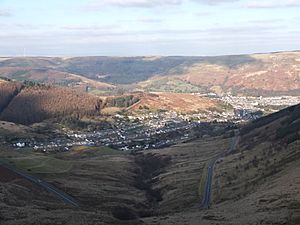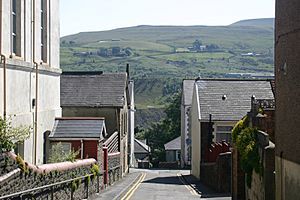South Wales Valleys facts for kids
The South Wales Valleys (Welsh: Cymoedd De Cymru) are a group of valleys in South Wales where many towns grew up because of industry. Most of these valleys run from north to south, side by side. People often just call them "The Valleys" (Welsh: Y Cymoedd). They stretch from Carmarthenshire in the west to Monmouthshire in the east. They are close to the countryside of the Vale of Glamorgan and the flat coastal areas near the cities of Swansea, Cardiff, and Newport.
Contents
History of the Valleys

Before the mid-1800s, not many people lived in the South Wales Valleys. Industry began to grow here in two main stages.
First, in the late 1700s, the iron industry started in the northern parts of the Valleys. Business people, mostly from England, set up ironworks. This made South Wales the most important place in Britain for making iron until the mid-1800s.
Second, from 1850 until the start of the First World War, the South Wales Coalfield was developed. This was to provide steam coal and anthracite, which were important fuels.
The South Wales Valleys had Britain's only coalfields in mountainous areas. The shape of the land meant that towns grew in a "hand and fingers" pattern, spreading along the valleys. For example, in 1851, fewer than 1,000 people lived in the Rhondda valley. By 1911, this number had jumped to 153,000! However, the towns remained like collections of villages rather than one big city because of the narrow valleys. Many young men moved to the Valleys from other parts of Wales and beyond to find work. The birth rates were very high in these new communities.
Merthyr Tydfil, at the top of the Taff valley, became Wales's largest town. This was thanks to its growing ironworks at Dowlais and Cyfarthfa. The nearby Taff Bargoed Valley became a place of serious industrial problems in the 1930s. This was especially true around the villages of Trelewis and Bedlinog, which served the local coal mines.
Many people moved from the countryside to the Valleys for coal mining jobs. Long rows of terraced housing were built along the valley sides for them. The coal dug from the mines was sent south by railways and canals to Cardiff, Newport, and Swansea. Soon, Cardiff became one of the most important coal ports in the world. Swansea became a major port for steel.
Decline of Industry
During World War II, the coal mining industry in the Valleys was very busy. But after the war, people worried that the industry would collapse again. There was hope when the government took control of British coal mines in 1947. This was called nationalisation. However, over the next few decades, less and less coal was mined in Wales.
The decline of coal mining after World War II happened across the country. But South Wales was hit harder than other areas. Oil became a more popular fuel than coal for many industries. Also, the demand for coal changed. Industries that still used coal wanted high-quality types, like coking coal for making steel. After the Clean Air Act of 1956, "smokeless" coal from South Wales became popular for home heating. But as demand from both these areas fell, the mining industry shrank even more. Exports of coal to other parts of Europe also dropped a lot.
Another big reason for the decline was that Welsh mines had not been updated for a long time. Most mines in the Valleys were built between the 1850s and 1880s. This meant they were much smaller and older than modern mines. They used old ways of ventilation, coal preparation, and power supply. In 1945, only 22% of coal in South Wales was cut by machines, compared to 72% across Britain. To keep the mines going, a lot of money was needed from the National Coal Board. But plans for the future demand for coal were too hopeful. Demand dropped a lot after 1956 because of an industrial slowdown and more oil being available. For example, in 1947, the Rhondda had 15,000 miners. By 1984, only one mine was still producing coal in the Valleys, at Maerdy.
In 1966, the village of Aberfan in the Taff valley suffered a terrible disaster. A pile of mine waste on the mountain, which had been built over a natural spring, slid down the hillside. It destroyed the village junior school, killing 144 people. Most of them were children.
In 1979, Margaret Thatcher became Prime Minister of the United Kingdom. Her ideas about a free market economy soon clashed with the government-owned National Coal Board, which was losing money. In 1984 and 1985, the government planned to close many mines. This led to a big strike by mineworkers. The strike eventually failed. This led to most of the UK's coal industry closing down over the next ten years. Today, no deep coal mines are left in the Valleys. The last one, Tower Colliery in the Cynon Valley, closed in 2008. Workers had bought this mine in 1994, even though the government wanted to close it.
The Valleys Today
The Valleys are home to about 30% of the people in Wales. However, this number is slowly going down as some people move away, especially from the Upper Valleys. Most residents (over 90% in places like Blaenau Gwent and Merthyr Tydfil) were born in Wales. The people in the Valleys are slightly younger on average than the rest of Wales.
The Valleys face some challenges. Fewer people have high school qualifications compared to other areas. Many people also report having long-term health problems, especially in the Upper Valleys. In 2006, only 64% of working-age people in the Heads of the Valleys had jobs. This was lower than the average for Wales.
Many local people work in manufacturing, health, and social services. Fewer people work in management or professional jobs compared to the rest of the country. Many people travel to Cardiff for work, especially from areas like Caerphilly, Torfaen, and Rhondda Cynon Taf. The train network into Cardiff is large, but train times and how often they run can make it harder for people to commute to city jobs from further up the valleys.
The houses in the Valleys are generally not worse than elsewhere in Wales. However, there isn't much variety in private homes. Many homes are older, terraced houses that are lower-priced. There are not many higher-priced detached homes. A report for the Welsh Government said that the Valleys are a "distressed area" with unique and concentrated problems in Great Britain. But the area also has beautiful scenery, better roads like the upgraded A465, and government money being spent to improve things.
Since the late 2000s, the Welsh Government has had more control over the Wales and Borders rail network. Because of this, money has been given to create a South Wales Metro. This new metro system will involve making train lines electric, using new trains from 2023, building new stations, having more frequent services, and making journeys faster across most valleys. One of the first big improvements is reopening services between Ebbw Vale and Newport, which is expected to be finished by 2021.
Culture in the Valleys
The South Wales Valleys have a large part of the Welsh population. They are still an important centre of Welsh culture, even though Cardiff is now more important economically. The first Labour Party MP in the UK, Keir Hardie, was elected from this area. The Valleys remain a strong area for the Labour Party. Rugby union is very popular, and you can see rugby fields all along the valleys.
The shape of the valleys also affects the culture. Roads run along the valleys and connect the different towns within them. But neighbouring valleys are separated by hills and mountains. This means that towns in one valley feel more connected to each other than they do to towns in a nearby valley, even if those towns are closer on a map.
Roads in the Valleys
The A470 from Cardiff is a dual-carriageway (a road with two lanes in each direction). It gives direct access to places like Taff's Well, Pontypridd, Abercynon, and Merthyr Tydfil. It connects with other main roads like the A4059, A472, and A4054.
| Section | From / To | Start Date | Finish Date | Status |
|---|---|---|---|---|
| 1 | Abergavenny to Gilwern | February 2005 | May 2008 | Complete |
| 2 | Gilwern to Brynmawr | December 2014 | Due by autumn 2021 | Under construction |
| 3 | Brynmawr to Tredegar | January 2013 | September 2015 | Complete |
| 4 | Tredegar to Dowlais Top | March 2002 | November 2004 | Complete |
| 5 | Dowlais Top to A470 | Early 2021 | Due by mid-2025 | Under construction |
| 6 | A470 Junction to Hirwaun | Early 2021 | Due by mid-2025 | Under construction |
Public Transport
Stagecoach in South Wales runs bus services that connect many towns and villages directly to Cardiff city centre.
Many towns in the Valleys are served by the Valley Lines network. This is a train network that spreads out from Cardiff. It connects these towns to Cardiff's main stations, like Cardiff Queen Street and Cardiff Central. From there, you can connect to the South Wales Main Line. There are six main train lines from Central Cardiff to the Valleys:
- Valley Lines via Cardiff Queen Street
- Rhondda Line to Pontypridd and then to Treherbert
- Merthyr Line to Pontypridd and Abercynon, continuing to either Aberdare or Merthyr Tydfil. There's also a freight-only section beyond Aberdare to Hirwaun.
- Rhymney Line to Rhymney. There's also a freight-only line from Ystrad Mynach to Cwmbargoed.
- Routes via the South Wales Main Line
- Maesteg Line to Bridgend and Maesteg
- Ebbw Valley Railway to Ebbw Vale
- Welsh Marches Line to Abergavenny, continuing to North Wales and North West England.
Valleys from West to East
- Gwendraeth Valley
- Amman Valley
- Loughor Valley (This valley forms the old border between Carmarthenshire and Glamorgan.)
- Swansea Valley (also known as Tawe Valley)
- Dulais Valley
- Vale of Neath
- Afan Valley
- Llynfi Valley
- Garw Valley
- Ogmore Valley
- Rhondda Valley
- Cynon Valley
- Aber Valley
- Ely Valley
- Taff Valley
- Taff Bargoed Valley
- Rhymney Valley (This valley forms the old border between Glamorgan and Monmouthshire.)
- Sirhowy Valley
- Ebbw Valley
- Ebbw Fach Valley
- Llwyd Valley






